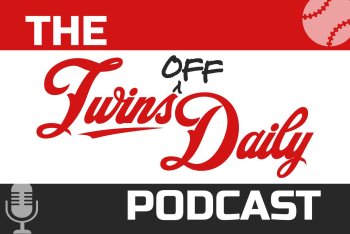
Twins Video
His first point, however, is that he doesn’t consider it framing. To Castro, “framing” sounds intentionally misleading -- like an act on a little league field where a youth catcher tries to yank a ball that crosses over the empty batter’s box back over the plate, hoping the high school-aged umpire who gets paid hourly has a momentary lapse of judgement. No, Castro doesn’t think of what he does as framing. He says it is simply receiving the ball the right way, which is to say, a skill an exemplary catcher should possess.
While Castro was with the Astros, the organization called their catchers together for an internal meeting and let them know that the nerds upstairs found something useful, something that they felt would give their team an edge. He says he wasn’t all too familiar with the concept at that time but the data and the added value it could provide made sense.
“You’d always as a catcher try to be quiet and receive the ball, it was a new way how to look at how to catch a baseball,” Castro said walking through how his former organization presented their argument.
At Stanford University, Castro said he developed and improved other core attributes for a catcher -- throwing out runners, blocking pitches, and general game calling abilities. The art of receiving was not one of those pillars. Now the Astros wanted him to add what they felt was a vital part of a catcher’s game. They had new technologies available and new ways to measure the contributions. Houston’s coaches showed the catchers tips and tricks that would, in theory, help obtain a few more strikes outside of the zone but, more importantly, keep pitches in the zone from being wrongly called balls.
While stealing strikes was an added benefit for the upgraded receiving techniques, the Astros’ main focus was not losing any strikes.
“Keeping strikes in the strike zone,” he explained. “Not doing anything to the pitch to take away from its quality. If it is on the corner and it is breaking one direction, you are trying to counteract the break so it doesn’t, by the time you catch the ball, pull your arm out of the zone.”
Houston’s efforts worked.
From 2009 through 2011 the Astros had an in-zone called strike percentage right at the league’s average. In terms of overall framing statistics, they were just outside of the top ten among all MLB teams. In short, they were actually pretty decent during a time before baseball put added emphasis on the practice. Good, not great. Over the last three seasons, meanwhile, Castro and the Astros have overtaken baseball as one of the game’s premiere receiving teams. Their in-zone called strike percentage was the second-highest in the game, just behind Buster Posey and the San Francisco Giants, and their overall framing runs rate was the fifth-highest.
What is the secret? Castro says it is planning and thinking ahead of the pitcher.
“When these guys throw 90-plus, 95-mile per hour sliders with really late, sharp break and if you are not preparing to catch the ball in a certain way, when you do catch it it is going to pull your glove out of the zone and it’s just how to think about how to counteract that force.”
There are people who will say that “framing” is overrated, overvalued, influenced by the pitcher, influenced by the umpire, doesn’t exist, or is waiting to be corrected by robots. Some will argue that if the pitch crosses the agreed upon confines of the strike zone, it shouldn’t matter what the catcher is doing. A strike is a strike and a ball is a ball. Whatever the outside sentiments might be about the statistic, within the current state of affairs receiving the ball correctly is a very real skill. Castro says he can feel when he is doing it right and when he is off.
“In the game you can tell if a pitcher makes a really good pitch and it's diving out of the zone and you catch it correctly to counteract the sink, you’re trying to stop the movement as soon as possible without taking you with it, you can feel when you do it right and when you are able to keep that ball in the zone and not let it pull you out.”
As the Giants and Astros have topped the leaderboard in that area, the Minnesota Twins have floundered at the bottom of the rankings, costing their pitching staff numerous strikes each season. Castro’s mindset is vastly different than the previously signed free agent catcher. When Kurt Suzuki was signed, he was asked about his thoughts on the increasing emphasis on pitch framing.
“I don’t put too much stock in that,” Suzuki said in 2014. “Don’t get me wrong, I think that has a lot to do with it but at the same time what a pitcher does has a lot to do with it. If he’s all over the place he’s obviously not going to get those borderline calls, not matter how good you make it look. If you are around the plate consistently, you are going to get those calls.”
Castro, on the other hand, was a lot less inclined to place the blame on his battery mate.
“There’s a general execution of a pitch helps the way a catcher receives it a lot,” Castro says. “If he’s generally around where you are trying to set up, it makes our job a lot easier. If they are spraying the zone a little bit more and you have to be reactive instead of being able to anticipate that makes it a lot more difficult.”
ESPN/TruMedia’s heat map comparison of Castro, Cervelli, Posey and Suzuki. Red is good, blue is bad.
This year’s pitching staff has been giving Castro’s work strong reviews so far. Trevor May, who recently suffered an unfortunate UCL tear that will take him out the remainder of the year, said he enjoyed working with Castro this spring.
"He adjusts where he sets up, based on the count and what he's looking for, and based on your stuff and how it moves,” May said. “Honestly, as a pitcher that gives you a lot of confidence, knowing that if he wants the ball a little off the plate or he wants the ball to come back over the plate or if he wants the outer-third for a strike you can tell based on how he's setting up and what he's calling. It's very clear. And he's a big target, he looks like Joe [Mauer] back there. So that's always nice."
Castro’s stature is somewhat of a hindrance for a catcher in the modern framing-centric era. Like May said, Castro is a big target. Mauer, at six-foot-five, struggled to get strikes called in the lower portion of the strike zone (something of a real problem for a staff that boasted sinker ball pitchers). At six-foot-three, catchers of Castro’s size are typically thought of as an issue, especially given the southward expanding strike zone. That said, Castro’s numbers suggest that he has been above average in that department, even with his size. That’s because, he says, he is mindful of his physique and he works particularly hard to ensure he is giving the umpire the best view of the strike zone.
“I’m a bigger catcher, so I figured it is something even more important for me to position myself to give the umpire a better lane to see the pitch,” he says. “That definitely helps. You can definitely tell when you are set up on one side of the plate and your pitcher misses, you can tell when you probably blocked the umpire from see where the pitch really crossed. For bigger guys, it’s something to take into account.”
It was not that long ago when finding a catcher with strong “framing” skills was a hidden value, something that data-savvy teams could exploit by acquiring backstop artists on the cheap.
That’s no longer the case.
When the Pittsburgh Pirates identified Russell Martin as a potentially strong receiver, they landed him on a two-year, $17 million contract - a fairly modest price for a decent two-way catcher. After he was credited as a key instrument in rejuvenating the Pirates’ pitching staff, Martin was wooed away from the Steel City to Toronto, where he was given a five-year, $82 million deal. The Pirates pivoted and traded left-handed reliever Justin Wilson to the Yankees for Francisco Cervelli. Cervelli proved to be another gem with the glove and contributed moderately with the bat as well. For that, he received a three-year, $31 million extension. By that comparison, at around $8 million a year, Castro has been a veritable bargain.
The Twins stress that Castro’s addition goes beyond how many strikes he can keep or steal. His defensive contributions are not one dimensional.
“I think everything was made exclusively around his pitch-framing, but we signed Jason with the idea that he had a number of other attributes outside of that,” Twins’ Chief Baseball Officer Derek Falvey told Twins Daily. “He does that well, no question, but leadership in the clubhouse, game planning, how he prepares a pitching staff, how he thinks about advance information, all those things he does exceptionally well and he’s impacting our guys here.”
Falvey also acknowledged that the organization is working diligently at improving the measurables of all catchers in the system. There is a chance that Castro will also be able to help bring along other catchers like Mitch Garver, who made significant improvements in the minor leagues last year.
“It’s a process,” says Castro. “It’s like anything else when you make a change it’s not going to be night and day, it’s going to be incremental and you just have to work at it until it becomes second nature.”
Think you could write a story like this? Twins Daily wants you to develop your voice and find an audience. We recruit our paid front page writers from our users blogs section. Start a blog today!
MORE FROM TWINS DAILY
— Latest Twins coverage from our writers
— Recent Twins discussion in our forums
— Follow Twins Daily via Twitter, Facebook or email
— Become a Twins Daily Caretaker











Recommended Comments
Create an account or sign in to comment
You need to be a member in order to leave a comment
Create an account
Sign up for a new account in our community. It's easy!
Register a new accountSign in
Already have an account? Sign in here.
Sign In Now